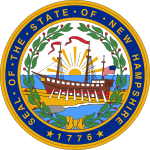| ||||||||||||||||||||||||||||
All 2 New Hampshire seats to the United States House of Representatives | ||||||||||||||||||||||||||||
|---|---|---|---|---|---|---|---|---|---|---|---|---|---|---|---|---|---|---|---|---|---|---|---|---|---|---|---|---|
| ||||||||||||||||||||||||||||
| ||||||||||||||||||||||||||||
| Elections in New Hampshire |
|---|
 |
The 2006 House of Representatives elections in New Hampshire took place on November 7, 2006, to determine who would represent the state of New Hampshire in the United States House of Representatives during the 110th Congress from January 3, 2007, until January 3, 2009.
New Hampshire had historically been a stronghold of the Republican Party. Both congressional seats were held by Republicans going into the election, in addition to most state and local offices. However, New Hampshire gave its four electoral votes to John Kerry in 2004 and to Bill Clinton in 1992 and 1996. Democratic governor John Lynch, who defeated incumbent Republican governor Craig Benson in 2004, was widely popular, and defeated his Republican opponent, Jim Coburn, in the simultaneous 2006 gubernatorial election. As a result, New Hampshire is commonly classified by the media as a tossup or battleground state in many federal elections.
In this particular election, Democrats were not initially expected to unseat either of the Republican incumbents, Jeb Bradley (NH-1) and Charlie Bass (NH-2). However, first district Democratic candidate Carol Shea-Porter and second district Democratic candidate Paul Hodes raised significant funds and ran more aggressive campaigns than Democrats had in years past. In a surprising upset, both Bass and Bradley were unseated by Hodes and Shea-Porter respectively on election day. This was the first time Democrats had held both New Hampshire House seats since 1915.


